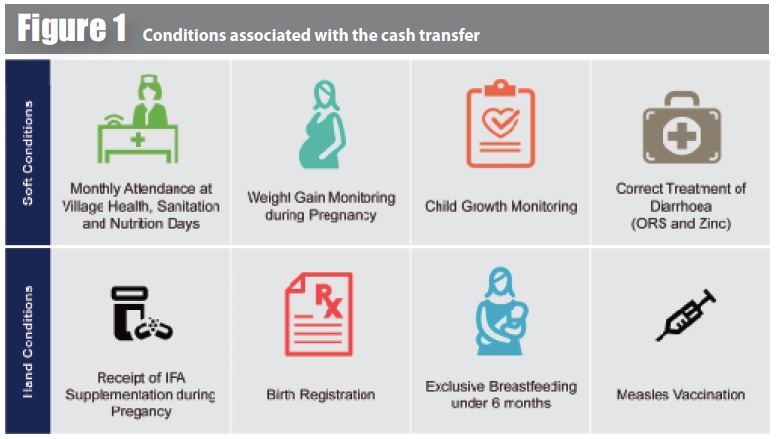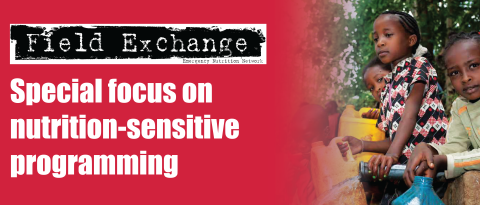WASH interventions and their effects on the nutritional status of children
Summary of research1
Location: Global
What we know: Water, sanitation and hygiene (WASH) interventions are frequently implemented to improve health and reduce infectious diseases and may be linked to child development outcomes, including nutrition.
What this article adds: The strength of evidence linking WASH with child nutrition was investigated in a review of fourteen 14 randomised and non-randomised studies from ten low- and middle-income countries. The (poor quality) evidence suggests a small benefit of short-term WASH interventions in children under five years of age;, specifically solar disinfection of water, provision of soap, and improvement of water quality, in children under five years of age. The gap in rigorous evidence will be bolstered by ?ve large RCTs underway. Q; outstanding questions remain on long-term adherence, optimal timing and required duration of WASH interventions for optimal impact.
 Globally, an estimated 26% of children (165 million) under the age of five years (165 million) suffer from chronic undernutrition manifested as stunting, and 8% (52 million) suffer from acute undernutrition manifested by extreme thinness or wasting.; Tthe largest numbers of undernourished children live in South Asia and Subsub-Saharan Africa. The two immediate causes of childhood undernutrition are inadequate dietary intake and infectious diseases such as diarrhoea. The integral role in health of safe water, sanitary disposal of human waste and personal hygiene has long been recognised. Water, sanitation and hygiene (WASH) interventions, such as provision of clean piped drinking water, enhanced facilities for excreta disposal and the promotion of hand-washing with soap, are frequently implemented to improve health and reduce infectious diseases and may be linked to child development outcomes. The objective of this review is to assess the strength of evidence linking WASH interventions with measures of child nutritional status and to identify research gaps.
Globally, an estimated 26% of children (165 million) under the age of five years (165 million) suffer from chronic undernutrition manifested as stunting, and 8% (52 million) suffer from acute undernutrition manifested by extreme thinness or wasting.; Tthe largest numbers of undernourished children live in South Asia and Subsub-Saharan Africa. The two immediate causes of childhood undernutrition are inadequate dietary intake and infectious diseases such as diarrhoea. The integral role in health of safe water, sanitary disposal of human waste and personal hygiene has long been recognised. Water, sanitation and hygiene (WASH) interventions, such as provision of clean piped drinking water, enhanced facilities for excreta disposal and the promotion of hand-washing with soap, are frequently implemented to improve health and reduce infectious diseases and may be linked to child development outcomes. The objective of this review is to assess the strength of evidence linking WASH interventions with measures of child nutritional status and to identify research gaps.
The review includes evidence from randomised and non-randomised interventions designed to (i1) improve the microbiological quality of drinking water or protect the microbiological quality of water prior to consumption; (ii2) introduce new or improved water supply or improve distribution; (3iii) introduce or expand the coverage and use of facilities designed to improve sanitation; or (iv4) promote hand-washing with soap after defecation and disposal of child faeces, and prior to preparing and handling food, or a combination of these interventions, in children aged under 18 years.
Method
Two review authors independently sought and extracted data on childhood anthropometry; , biochemical measures of micronutrient status; , and adherence to, attrition of and costs of the study interventions either from published reports or through contact with study investigators. The authors calculated mean difference (MD) with 95% confidence intervals (CI) and conducted study-level and individual-level meta-analyses to estimate pooled measures of effect for randomised controlled trials (RCTs) only.
Results
Fourteen studies from ten low and middle-income countries involving a total of 22,241 children at baseline, and nutrition outcome data for 9,469 children, are included in this review. All studies included children under ?ve years of age years of age at the time of the intervention. The review included five cluster-randomised controlled trialsRCTs, (RCTs), one three-year follow-up of a cluster-RCT, and eight non-randomised studies with comparison groups. Studies included various WASH interventions either singly or in combination that aimed to improve the quality and quantity of water, and improve sanitation and hygiene.
Study duration ranged from six6 to 60 months. Measures of child anthropometry were collected in all 14 studies and nine studies reported at least one of the following Z-z score anthropometric indices: weight-for-height (WHZ), weight-for-age (WAZ) or height-for-age (HAZ). None of the included studies were of high methodological quality as the nature of the intervention was not masked from any participants.
Study-level and individual participant data (IPD) meta-analysis was limited to data from five cluster-RCTs with durations of 9-9 to 12 months. Meta-analysis including 4,627 children identified no evidence of an effect of WASH interventions on WAZ (MD 0.05; 95% CI -0.01 to 0.12). Meta-analysis including 4,622 children identified no evidence of an effect of WASH interventions on WHZ (MD 0.02; 95% CI -0.07 to 0.11). However, meta-analysis including 4,627 children showed that WASH interventions (specifically solar disinfection of water, provision of soap and improvement of water quality) had a slight but significant effect on HAZ in children under 5 years of agefive (MD 0.08; 95% CI 0.00 to 0.16). In sub-group analysis of data from cluster-RCTs, there was some evidence to suggest a difference in effect by gender and age group, with girls more responsive than boys in weight and height growth to WASH interventions; height growth more responsive to WASH interventions in children under 24 months of age; and weight growth more responsive to WASH interventions in children aged 25-60 months of age.
Adherence to study interventions was reported in only two studies (both cluster-RCTs) and ranged from low (< 35%) to high (> 90%). Study attrition was reported in seven studies and ranged from 4% to 16.5%. Intervention cost was reported in one study in which the total cost of the WASH interventions was USD 15 per /inhabitant. None of the studies reported differential impacts relevant to equity issues such as gender, socioeconomic status and religion.
Conclusions
The authors conclude that available evidence from meta-analysis of data from cluster-RCTs with an intervention period of 99-12 months is suggestive of a small benefit of WASH interventions (specifically solar disinfection of water, provision of soap, and improvement of water quality) on length growth in children under five years of age years of age. The quality of evidence is generally poor and the overall estimates presented are based only on meta-analyses of data from interventions of relatively short duration (99-12 months) from only a small selection of WASH interventions. These estimates are therefore not applicable to the effect that wider WASH interventions may have on child nutritional status.
The authors also conclude that this review has identified the paucity of rigorous evidence evaluating the effect of WASH interventions on child nutritional status. There are ?Five large RCTs are underway, which will contribute significantly to the existing evidence base linking WASH interventions to child nutritional status outcomes (see Box 1). Further research questions relate to the mechanism of action of the WASH interventions. There is no evidence on long-term adherence to WASH interventions, the optimal timing of interventions in childhood or the required duration of interventions to have the greatest impact on childhood nutrition outcomes.
Box 1: RCTs underway on WASH interventions and nutrition outcomes
Clasen T., Boisson S., Routray P., Cumming O., Jenkins M., Ensink J.H.J., et al. The effect of improved rural sanitation on diarrhoea and helminth infection: design of a cluster randomised trial in Orissa, India. Emerging Themes in Epidemiology 2012;9 (1):7.
Johns Hopkins Bloomberg School of Public Health. Sanitation, Hygiene, Infant Nutrition Ef?cacy Project (SHINE). http://clinicaltrials.gov/ct2/show/NCT01824940.
Innovations for Poverty Action. WASH Benefits Bangladesh: A Cluster Randomized Controlled Trial of the Benefits of Water, Sanitation, Hygiene Plus Nutrition Interventions on Child Growth. http://clinicaltrials.gov/show/NCT01590095; Innovations for Poverty Action.
WASH Benefits Kenya: A Cluster Randomized Controlled Trial of the Benefits of Sanitation, Water Quality, Handwashing, and Nutrition Interventions on Child Health and Development. http://www.clinicaltrials.gov/ct2/show/NCT01704105.
Footnotes
1 Dangour, A.D.,; Watson, .L,; Cumming, O.,; Boisson, S.,; Che,, Y.,; Velleman,, Y.,; Cavill, S.,; Allen, E.,; Uauy, R. (2013) Interventions to improve water quality and supply, sanitation and hygiene practices, and their effects on the nutritional status of children. Cochrane Database Syst Rev, 8. CD009382. ISSN 1469-493X.


